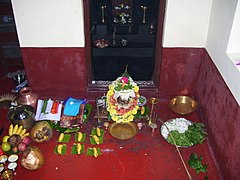Satya Narayan (Hindu deity)
This article needs additional citations for verification. (August 2017) |
| Satya Narayan | |
|---|---|
 | |
| Devanagari | सत्यनारायण |
| Affiliation | Deva, aspect of Vishnu |
| Mantra | Om Namo Bhagavate Vasudevaya (ॐनमोभगवतेवासुदेवाय) |
| Weapon | Sudarshana Chakra |
| Symbol | Banana tree |
| Mount | Garuda |
| Consort | Lakshmi |
| Part of a series on |
| Hinduism |
|---|
 |
Satya Narayan is a deva form of Vishnu who is worshipped by Hindus, mainly in the Indian states of Gujarat, Madhya Pradesh, Maharashtra, Punjab, Haryana, Chandigarh, Uttar Pradesh, Chhattisgarh, West Bengal, Jharkhand, Bihar, Assam, Manipur and Tripura. His avatar is Krishna. Satya Narayan is part of a triad on the ratnavedi (jewelled platform).
Festivals
Satya Narayan is honoured at the Saty Narayan Ji Temple (mandir) in Nabha, at the Rath Yatra Nabha, and as part of the Holi festival. The large chariots of Jagannath (another aspect of Vishnu) which are pulled during a Ratha-Yatra form the etymological origin of the English word juggernaut.[1]
Puja
The present puja to the deva originated in the syncretism of Hindu and Sufi traditions in Bengal during the Middle Ages, when the Hindu Satya Narayan became the Muslim Satya Pir.[2] The puja is also performed by some Buddhists in Bangladesh.[3]
Gallery
-
Ratha-Yatra chariots in Puri
-
Worshippers in Puri
-
Painting of Vishnu seated on a lotus
-
A kalasha and other puja items
-
Satya Narayan puja
References
- ^ "Juggernaut-Definition and Meaning". Merriam Webster Dictionary. Retrieved 28 November 2012.
- ^ Yamin, Mohammed (2009). Impact of Islam on Orissan Culture. New Delhi: Readywirthy Publications. p. 59. ISBN 978-81-89973-96-4.
- ^ Barua, Dilip Kumar. "A case study in the popular Buddhist belief in Bangladesh" (PDF). Society for the Study of Pali and Buddhist Culture: 96.







